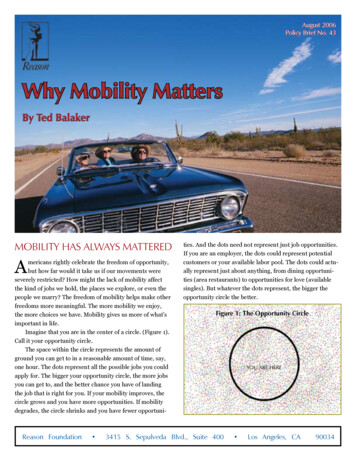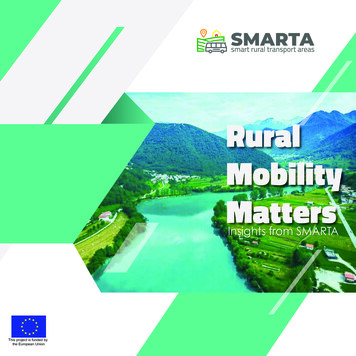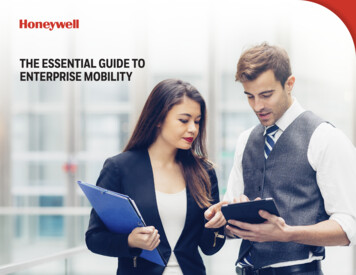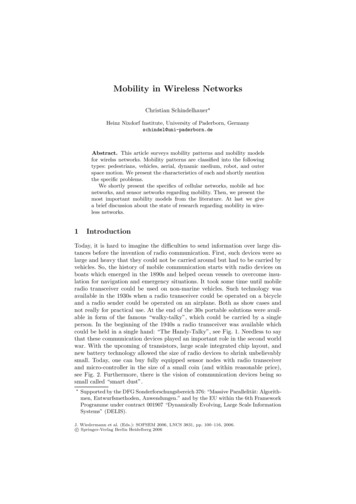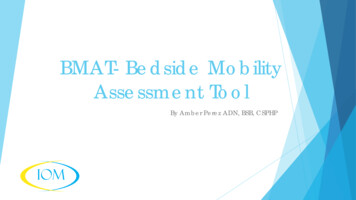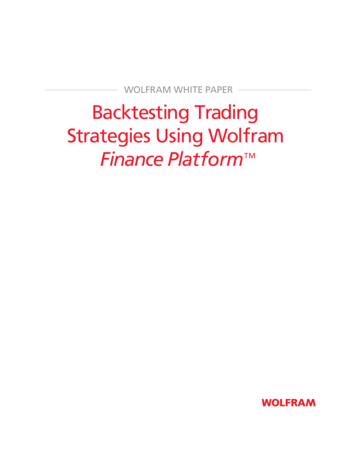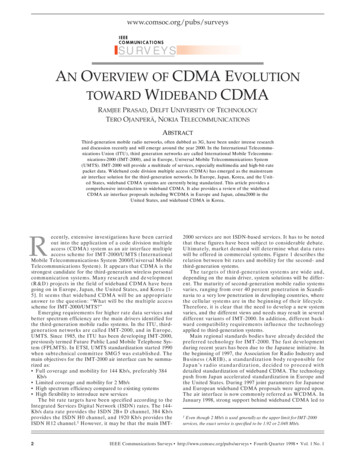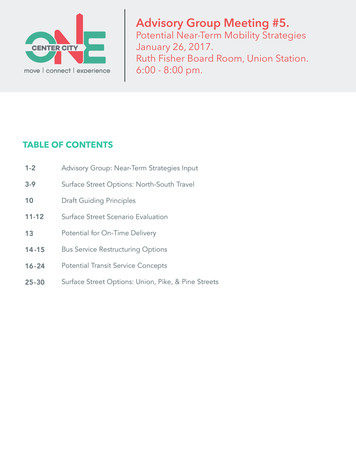
Transcription
Advisory Group Meeting #5.move connect experiencePotential Near-Term Mobility StrategiesJanuary 26, 2017.Ruth Fisher Board Room, Union Station.6:00 - 8:00 pm.TABLE OF CONTENTS1-2Advisory Group: Near-Term Strategies Input3-9Surface Street Options: North-South Travel10Draft Guiding Principles11-12Surface Street Scenario Evaluation13Potential for On-Time Delivery14 -15Bus Service Restructuring Options16 -24Potential Transit Service Concepts25 -30Surface Street Options: Union, Pike, & Pine Streets
ADVISORY GROUPNear-Term Strategies InputHelping Address Near-Term MobilityChallenges Seattle faces an enviable challenge - managing growth spurredby one of the nation’s strongest economies and the draw of avibrant city located in a spectacular region of the world. Growth is driving increased demand for access and mobility in atime when construction projects seem omnipresent. Sound Transit light rail will be extended to Northgate by 2021and Lynnwood and the Eastside (East Link) by 2023, providingimportant new access to the Center City.Near-TermJAN 12and ChallengesPresentationJAN 26 Seattle residents and regional commuters need safe, affordable,comfortable, reliable and convenient transportation options to,through, and within Center City. One Center City will identify a set of recommended strategies toaddress near-term mobility challenges and prioritize public realminvestments, providing safe and reliable options for all users.Opportunitieson PotentialStrategiesDiscussionFEB 9of PotentialStrategiesMARCHRecommendedStrategies ForFurther Evaluationand OutreachPublic andAPRILStakeholderOutreachCouncil andBoard DecisionProcesses1
Key Roles of the Advisory Group Focus on alignment with adopted One Center City Draft GuidingPrinciples. Consider the balance of bus service restructuring and surfacestreet capital projects to guide the technical team in developing adraft preferred set of strategies. Share feedback on specific proposals to help refine the concepts.This input will be considered before proposals move into abroader public involvement process. Members are not asked to be technical experts.Final recommendations will require approval from the Seattle City Council,the Metropolitan King County Council, and the Sound Transit Board ofDirectors. In the coming months King County Metro Transit and SoundTransit will seek customer comments on potential changes to bus routes.In reviewing various projects and service options, we need your input on:Values Alignment How various service proposals, capital projects, and operationsstrategies align with the One Center City Draft GuidingPrinciples.See One Center City Draft Guiding Principles sheet.Balance How should we prioritize limited rights-of-way? (Transit, SOVs,pedestrian, parking etc.) How should we invest in operating bus routes differently vs.operating streets differently? How can we accomodate mobility and access needs whilecreating vibrant, functional public spaces? What issues are your communities going to be most interested inor most concerned about? Are there other strategies that need to be on the table?Stakeholder Interests and Communication Changes to streets and public spaces affect many stakeholdergroups. Options and tradeoffs will be communicated morebroadly over the coming months.2JOIN THE CONVERSATIONAND LEARN MORE AT:onecentercity.org
SURFACE STREET OPTIONSNorth-South TravelWhat is the Challenge and the Opportunity? Center City mobility and access demands are growing rapidly; there is very limited additionalpublic right-of-way on surface streets to accommodate travel growth. Center City streets, particularly north-south avenues in downtown, have many mobility andaccess priorities to balance, including:» Safe facilities for people walking and on bicycles» Curb uses, including commercial loading, passenger loading, and short-term parking» Transit operations and passenger facilities» General purpose traffic» Freight and commercial vehicle movements» Active uses of the public realm. Local and regional bus services provide critical access to Center City jobs and services. Major changes in Center City, including the end of bus operations in the Downtown SeattleTransit Tunnel, opening of the Center City Streetcar, closure of the Alaskan Way Viaduct, andother regional projects, will put pressure on already strained surface streets. If Downtown Seattle Transit Tunnel buses are moved on to surface streets in conjunction withthe Viaduct coming down and reduced capacity on 1st Avenue, projections show regionalbuses on 2nd and 4th Avenues will slow to speeds of just 3 to 4 miles per hour during theafternoon peak period without capital investments to improve surface operations.What Options Will You Review?Four scenarios for 2019:A. Baseline, representing 2019conditions with no One CenterCity actions or investments (“DoNothing”)B. Operational Enhancements on2nd, 3rd, and 4th AvenuesC. 2019 4th Avenue & 5th AvenueTransit CoupletD. 5th Avenue Transit Spine3
What Do the Draft Options Include? These options are packages of surface street projects representing different approaches to addressingnear-term access and mobility challenges. Options for improving transit, bicycle facilities, pedestrian and public realm, and general purposetraffic operations were considered for each major corridor and the system as a whole. Options emphasize solutions for transit following the end of bus operations in the Downtown TransitTunnel (as early as Fall 2018) and before future light rail extensions, which will reduce downtown busvolumes (2021/2023). Options assume all tunnel buses move to surface street pathways. Certain corridor projects can be implemented independently; others rely on other capitalimprovements or service adjustments. The Dashboard provides a comparison of each scenario to existing (2016) conditions.What Happens Next with the Draft Options? One Center City Interagency Team members will review AdvisoryGroup input and consider it along with technical analysis, additionalstakeholder feedback, and public comment to develop a draft set ofpreferred near-term projects and strategies. Draft Recommended Strategies will bepresented for Advisory Group review at theMarch meeting. Before any decisions are made, surfacestreet options identified in the One CenterCity planning effort will go through aseparate public involvement process.JOIN THE CONVERSATIONAND LEARN MORE AT:4onecentercity.org1
OPTION A:BASELINE OR “DO NOTHING” (2019)1st Ave2nd AveTFADowntown SeattleTransit Tunnel3rd Ave4th Ave5th Ave6th AveExisting* Typical cross sections between Spring St and Madison St looking north. Curb parking/loading not shown except where subject to change.SBWhat is Changing?Option A ConceptTravel LaneSBTravel LaneSBTravel LaneSBStreetcarNBTravel LaneNBStreetcarSBNBTravel LaneTravel Lane Center City ConnectorStreetcarTravel LaneSBTravel Lane2-wayParking /Loading& Left-TurnProtectedBike LaneSBSBNBSBNBTransit Only Lane Transit Only Lane Transit Only Lane Transit Only LaneRDNBNB NorthboundSB SouthboundTransit Only LaneSBSBTransit Only LaneSBTravel LaneSBTravel Lane2-wayParking /Loading& Left-TurnProtectedBike Lane Downtown Seattle TransitTunnel bus routes operatesouthbound on 2nd Ave One lane each directionrepurposed for transit lane Existing 2-Way protectedbike lane is extendednorth to Denny and southto Jackson (current SDOTproject) Traffic volumes increase10-15% due to temporaryAlaskan Way closure andlane repurposing on 1st AveSBSBNBNBTransit Only Lane Transit Only Lane Transit Only Lane Transit Only Lane Same as todayNBLight-Rail/ BusLight-Rail/ BusSBNBLight-RailLight-Rail Light rail only Light rail headwaysame as todayParking &LoadingParking &LoadingNBNBNBNBNBSBSBSBNBNBNBBike LaneTravel LaneTravel LaneTravel LaneTransit Only LaneTravel LaneTravel LaneTravel LaneTravel LaneTravel LaneTravel LaneNBNBNBNBNBSBSBSBNBNBNBBike LaneTravel LaneTravel LaneTravel LaneTransit Only LaneTravel LaneTravel LaneTravel LaneTravel LaneTravel LaneTravel Lane Downtown Seattle Transit Tunnelbus routes operate northboundon 4th Ave Same as today Traffic volumes increase 10-15%due to temporary Alaskan Wayclosure and lane repurposing on1st AveKEY TAKEAWAYS: 5Bus trips are longer and less reliable for transit customers on 2nd, 4th, and 5th AvenuesTransit agencies pay more to maintain current service levelsSeveral key bus stops are overcrowded during the PM peak, affecting pedestrian movementsLight rail reliability improves in Downtown Seattle Transit TunnelDrivers have longer peak trips due to traffic shifting from Alaskan Way and 1st Avenue and increased bus volumesChallenging to implement northbound and southbound protected bike lane east of 3rd Ave Same as today
OPTION B:OPERATIONAL ENHANCEMENTS ON 2ND, 3RD, 4TH, & 5TH AVENUES (2019)1st Ave2nd AveTFADowntown SeattleTransit Tunnel3rd Ave4th Ave5th Ave6th AveExisting* Typical cross sections between Spring St and Madison St looking north. Curb parking/loading not shown except where subject to change.SBTravel LaneSBTravel LaneNBTravel LaneSBNBTravel LaneTransit Only LaneSBTravel LaneSBTravel Lane2-wayParking /Loading& Left-TurnProtectedBike LaneSBSBNBNBTransit Only Lane Transit Only Lane Transit Only Lane Transit Only LaneSBNBLight-Rail/ BusLight-Rail/ BusParking &LoadingNBNBNBNBNBSBSBSBNBNBNBBike LaneTravel LaneTravel LaneTravel LaneTransit Only LaneTravel LaneTravel LaneTravel LaneTravel LaneTravel LaneTravel LaneNBNBNBTravel LaneTravel LaneTravel LaneOption B ConceptWith sidewalk reductionSBTravel LaneSBStreetcarNBStreetcarNB NorthboundSB SouthboundWhat is Changing? Same as BaselineRDNBTravel LaneSBTransit Only LaneSBTravel LaneSBTravel Lane2-wayParking /Loading& Left-TurnProtectedBike LaneSBSBNBNBTransit Only Lane Transit Only Lane Transit Only Lane Transit Only LaneProtected/permissive right-turn Bike LaneTravel LaneTravel LaneTravel LaneTransit Only LaneProtected/permissive right-turn phasing Intersection improvements at Opportunities to speed Same as Baselinewestbound cross streets (i.e.,boarding at bus stops areMadison & Columbia)pursued Intersection improvements ateastbound cross streets (i.e.,Cherry, Marion, Spring, Pike) Signal phasing that allowstransit lane to clear of rightturning vehicles Signal phasing that allows transitlane to clear of right turningvehicles Allows some buses torelocate from 2nd & 4thAves Improvements topassenger environment &organization at crowdedbus stops Northbound protected bike lane(assume paired with southboundlane on 5th Ave)SBSBSBSBProtectedBike LaneTravel LaneTravel LaneTravel LaneWith lane reductionSBSBSBProtectedBike LaneTravel LaneTravel Lane Southbound protectedbike lane would requirerepurposing a travellane or moving curbsand possibly removingtrees Reduction to two travellanes would requireadditional investment intwo-way 6th AveKEY TAKEAWAYS: Modest operational improvements for transit on 2nd and 4th Avenues, but potential improvements to speed boarding allowsome regional routes to relocate to 3rd Avenue Opportunity to implement 4th and 5th Avenue protected bike lane couplet Low capital investment allows easier implementation before Fall 20186 Same as Baseline
OPTION C:4TH & 5TH AVENUE TRANSIT COUPLET (2019)1st Ave2nd AveTFADowntown SeattleTransit Tunnel3rd Ave4th Ave5th Ave6th AveExisting* Typical cross sections between Spring St and Madison St looking north. Curb parking/loading not shown except where subject to change.SBOption C ConceptTravel LaneSBTravel LaneSBTravel LaneSBStreetcarNBTravel LaneNBStreetcarSBNBTravel LaneTransit Only LaneSBTravel LaneSBTravel Lane2-wayParking /Loading& Left-TurnProtectedBike LaneSBSBNBWhat is Changing? Same as BaselineLight-Rail/ BusTransit Only Lane Transit Only Lane Transit Only Lane Transit Only LaneRDNBTravel LaneSBTransit Only LaneSBTravel LaneSBTravel Lane2-wayParking /Loading& Left-TurnProtectedBike LaneSBSBNB Intersection improvements at Same as Baselinewestbound cross streets (i.e.,Madison, Columbia) Signal phasing that allowstransit lane to clear of rightturning vehiclesNBTransit Only Lane Transit Only Lane Transit Only Lane Transit Only LaneProtected/permissive right-turn phasingNB NorthboundSB SouthboundSBNBNBParking &LoadingLight-Rail/ BusNBNBNBNBNBSBSBSBNBNBNBBike LaneTravel LaneTravel LaneTravel LaneTransit Only LaneTravel LaneTravel LaneTravel LaneTravel LaneTravel LaneTravel LaneSBNBNBTravel LaneTravel LaneTravel LaneSBNBNBNBNBLight-RailLight-RailTravel LaneTravel LaneTravel Lane Same as BaselineNBNBTransit Only Lane Transit Only LaneSBSBSBTransit Only LaneTravel LaneTravel LaneProtected/permissive right-turn phasing Second northbound transit laneadded 7SB5NBNBTravel LaneTo SB I-5Travel LaneTravel Lane One lane repurposed Converted to two-wayto create southboundstreet between Stewarttransit laneand MarionDual transit lane adds capacity Southboundtravel lane More bus service movedfor busesprovides additionalto 5th Avenue to takecapacity for I-5 accessCurrent skip stop patternadvantage of transitfrom North Downtown,retainedlaneDenny Triangle,Signal phasing that allows transit One travel lanes northBelltown, and Southof Madison, three southlane to clear of right turningLake Unionof Madisonvehicles 5th Ave transit lane isdependent on two-wayDoes not allow room for bike lane Does not allow room for6th Avebike laneKEY TAKEAWAYS: Spring to UniversityAdds one full lane of transit capacity northbound and southboundRepurposing lane for transit on 5th Avenue necessitates new southbound lane on 6th Avenue; important for access to I-5 SouthVery difficult to implement northbound or southbound protected bike lane east of 3rd AvenueSidewalk crowding is an issue on 2nd, 4th, and 5th AvenuesBus passengers may have to walk further uphill/downhill to access transitHas the most significant reduction in on-street parking and loading during the peak periodMore intensive capital projects such as two-way 6th Avenue will require expedited process to implement by Fall 2018
OPTION D:5TH AVENUE TWO-WAY TRANSIT SPINE (2019)1st Ave2nd AveTFADowntown SeattleTransit Tunnel3rd Ave4th Ave5th Ave6th AveExisting* Typical cross sections between Spring St and Madison St looking north. Curb parking/loading not shown except where subject to change.SBOption D ConceptTravel LaneSBTravel LaneSBTravel LaneSBStreetcarNBTravel LaneNBStreetcarNB NorthboundSB SouthboundWhat is Changing? Same as BaselineSBSBNBTravel LaneTransit Only LaneTravel LaneSBTravel Lane2-wayParking /Loading& Left-TurnProtectedBike LaneSBSBNBNBTransit Only Lane Transit Only Lane Transit Only Lane Transit Only LaneRDNBTravel LaneSBPeak GP /Off-Peak ParkingSBTravel Lane2-waySBTravel LaneParking /Loading& Left-TurnProtectedBike Lane Southbound transit laneremoved West curb lane used forgeneral traffic during peakand parking/loading duringoff peak Most transit service relocatedto 5th AveSBSBNBNBTransit Only Lane Transit Only Lane Transit Only Lane Transit Only Lane Same as BaselineSBNBLight-Rail/ BusLight-Rail/ BusSBLight-RailNBLight-Rail Same as BaselineParking &LoadingNBNBNBNBNBSBSBSBNBNBNBBike LaneTravel LaneTravel LaneTravel LaneTransit Only LaneTravel LaneTravel LaneTravel LaneTravel LaneTravel LaneTravel LaneSBNBNBTravel LaneTravel LaneTravel Lane2-wayNBNBNBProtectedBike LaneTravel LaneTravel LaneTravel LaneNBPeak GP /Off-Peak ParkingSBBus Stop8NBSpring to UniversityTransit Only Lane Transit Only Lane Transit Only LaneNote: Center lane alternates between NB and SBto allow buses to pass at stops.SBTravel Lane Northbound transit lane removed Transit only during peak East curb lane used for generaltraffic during peak and parking/loading during off peak Most transit service relocated to5th Aveperiods from Stewart toJackson Operates similar to 3rdAve Transit Spine; transitonly at peaks with limitedaccess and delivery Most bus servicesusing 2nd & 4th Avesconsolidate to 5th Ave Signficantly altersthe existing 5th Avestreetscape and tree lineKEY TAKEAWAYS: SBConcentrates transit service on 1st, 3rd, and 5th AvenuesDuring peak, most surface transit is operating in a transit-only laneSimplifies street operation as there are very limited turn movements from 5th Avenue during peak periodsSimplified traffic operations reduce driver delay, but would change access to some buildings & garagesBus passengers may have to walk further uphill/downhill to access transitIntroducing new bus stops on 5th Avenue would require impact streetscape and require some tree removal5th and 6th Avenue project elements are capital intensive; design/outreach would make Fall 2018 completion challenging5NBNBTravel LaneTravel Lane Converted to two-waystreet between Stewartand Marion Southbound travel laneprovides additionalcapacity for I-5 accessfrom North Downtown,Denny Triangle, Belltown,and South Lake Union 5th Ave peak transit onlyoperation is dependenton two-way 6th Ave
NORTH/SOUTH SURFACE STREET OPTIONS OVERVIEWChange from TodayChange in Transit TravelTime & ReliabilityOption B: OperationalEnhancements to2nd, 3rd, 4th, & 5thOption A:2019 Baseline(Downtown Bus Riders)Northbound:per rider during peak periodaverage of 4th & 6th Ave 3.5 min.Reliability:Option C:4th & 5th AvenueTransit Couplet 7- 8Mannuallyper rider during peak periodReliability:MED 1.7 min.per rider during peak periodReliability: 3.0 min.Northbound:NoChangeper rider during peak periodReliability:HIGHNo Changeannuallyaverage of 4th & 6th Ave 2.8 min.average of 2nd, 5th, & 6th AveNorthbound: 0.5 1M 1.2 min.average of 4th & 6th AveCommercialLoad Zones: 3.4 min.average of 2nd, 5th, & 6th AveNorthbound: 0.7 min.average of 4th & 6th Ave /- 0MannuallyParkingStalls:Southbound:No Changeaverage of 2nd, 5th, & 6th Ave3RD4TH-12ND-43RD-254THduring PM peak periodCommercialLoad Zones:PassengerLoad Zones:Southbound:Opportunity to ImplementNorthbound and SouthboundProtected Bike Lane(East of 3rd Ave)Potential for engerLoad Zones:Southbound:Surface Street ProjectCapital CostTFANoChangeRD 1.5 2.5MannuallyMEDSouthbound:Pedestrian Experience atHubs and Major Bus Zones2NDaverage of 2nd, 5th, & 6th AveTravel Time: 1.9 min.Change in On-StreetParking & Loading Spaces 0.3 min.LOWTravel Time:Option D:5th Avenue Two-WayTransit Spine(Bus Only)General Purpose TrafficTravel TimeTravel Time:Travel Time:9Additional DowntownTransit Operating CostsParkingStalls:5TH-62ND-193RD-454THduring PM peak period-32NDPassengerLoad Zones:-43RD-364THduring PM peak period 14- 17M5THCommercialLoad Zones:ParkingStalls: 11- 14M5TH 22- 28M
The draft guiding principles below were developedbased upon feedback received at the November 10Advisory Group meeting as well as a follow-up meetingbetween agency staff and several Advisory Groupmember volunteers held on November 22. These includerefinements from the January 12 meeting.Draft Guiding PrinciplesEquity: Design for the health, safety and well-being of all who live in our community usingestablished race and social justice guidelines.Flexibility: Create flexible systems that can evolve over time by taking a system-wide viewand challenging long-held assumptions.Optimization: Optimize use of limited street and sidewalk space for people and goods.Public space: Design the street experience and public realm so that they are inviting,engaging, safe and supportive of social connections and community-building.Stewardship: Reduce vehicles and emissions and use sustainable building practices.Transportation: Provide safe, affordable, comfortable, reliable and convenienttransportation options for all users of all abilities – daytime and nighttime, commuters andnon-commuters, and those needing timely multiple connections.User experience: Create an easy to use and intuitive system by prioritizing accessibility,pedestrian mobility, wayfinding, and multimodal connectivity.Well-being: Support social sustainability and economic prosperity for all.10
SURFACE STREET SCENARIO EVALUATIONPreliminary Measures used for Surface StreetDashboardThe following can be used as a reference sheet for reviewing potential Surface Street Options and thepreliminary measures that were used to assess them.MeasureChange in Transit TravelTime and Reliability:Downtown Bus RidersGuiding PrinciplesWhat Are WeHow Was the RatingKey Assumptions ienceChange in travel time andreliability for bus riderstraveling to and throughdowntown.Calculated using trafficand bus stop operationsmodel, includes traveltime and reliability on2nd, 4th, and 5th Ave.Bus riders on transittunnel routes currentlyexperience higher travelspeeds and betterreliability throughdowntown, and willexperience a greaterdegradation than busriders using currentsurface street routes.Change in annual bustransit operating costsresulting from increasedtravel times for busesoperating on surfacestreetsAdditional transit delaycompared to existingconditions.Does not accountfor other changes indowntown traffic ortransit operations such aschanges related to EastLink construction andwaterfront onal DowntownTransit Operating CostsWell-beingCalculated using a busstop operations modelthat evaluates: Delay because busesare backed up at busstops Additional dwell timedue to increasedpassenger volumes Additional time toreach layoverGeneral Purpose TrafficTravel TimeTransportationEquityStewardship11Average amount ofadditional time autodrivers and passengersspend traveling throughdowntown duringafternoon peak period.Modeled using trafficoperations models thatsimulate traffic operationsincluding generalpurpose traffic, buses,bicycles, and pedestrians.All costs in 2016 dollars,does not include LightRail operating costs.Traffic pattern changesresulting from lanechanges on 1st Avenuedue to Center CityConnector streetcar andtemporary closure ofAlaskan Way taken intoaccount.Includes travel north orsouth on 2nd, 4th, 5th,and 6th Aves, or east orwest on Pike and PineStreets.
MeasureOpportunity toImplement ProtectedBike LaneGuiding PrinciplesWhat Are WeHow Was the RatingKey Assumptions ty toimplement a newprotected bike lane inboth the northbound andsouthbound directionseast of 3rd Ave, and inboth directions on thePike-Pine Corridor.Evaluated performance ofgeneral purpose auto andtransit with inclusion ofprotected bike lane usingVissim traffic operationsmodel.The degree to whichwaiting bus passengersimpede pedestrianmovement on sidewalkswhere bus stops arelocated.Estimated density ofwaiting bus passengers,pedestrian volumes,and other physicalimpediments from streetfurniture, n Experienceat Transportation Hubsand Major Bus StopsUserexperienceOptimizationWell-beingon travel times fortransit and auto travelersMED has some impact,but impact may bereduced if combined withother strategies (surfacestreet or serviceintervention)LOW has significantimpact on traveltimes for transit and autoHIGH sidewalks operatewell for pedestrianspassing bus stopMED pedestrianmovements areconstrained during peakperiodsLOW waiting buspassengersregularly block pedestrianmovementPublic spaceSurface Street CapitalProject CostsHIGH has limited impactThe total capital costof all surface streetimprovements included inthe scenario.Calculated using SDOTcapital costing tools andunit costs from recentprojects.The change in numberof on-street parking andloading stops resultingfrom scenario projectsand number of drivewaysthat have access patternsaffected (not required toclose) .Counted number ofon-street parking,and commercial andpassenger loading areasdisplaced by capitalproject options.Likelihood to design,receive environmentalclearances, contract,and construct the set ofprojects within the fall2018 timelineDetailed scheduleassessment usingSDOT’s capital projectassessment tool.All costs in 2016 dollars.OptimizationChange in On StreetParking and LoadingSpacesUserexperienceTransportationPublic spaceFlexibilityPotential for On TimeDeliveryWell-beingFlexibilitySchedule assessmentconsidered a numberof possible options forexpedited design anddelivery.LOW significant riskconstruction willnot be complete by fall2018MED moderate riskconstruction willnot be complete by fall2018HIGH very low riskconstruction willnot be complete by fall201812
POTENTIAL FOR ON-TIME DELIVERYImplementation Timeline And RisksThe surface street capital projects listed below are those considered in developing the rating shown on theSurface Street Options (N-S Avenues) sheets. They are rated High to Low, with High meaning the project has ahigh potential for on-time delivery and Low meaning the project has low potential for on-time delivery.Improvement StrategyConstruction TimelinePublic, Customer,Other Capital ProjectsStakeholderConflict2nd Ave Spot Improvements P/P Right Turn PhasingHIGHStandardscheduleHIGHMinimal changeto l changeto streetoperationsHIGHNoneMEDNeed expeditedscheduleMEDModeratechange to streetoperationsHIGHNoneMEDNeed expeditedscheduleMEDModeratechange to streetoperationsMEDDenny Substation& UW TowerProjectLOWNeed expeditedschedule,environmentaldetermination ofnon-significanceand streamlinedpublic processLOWMajor change totransit routings,street operations,driveway accessand parkingfacilitiesLOWDennySubstation, UWTower ProjectLOWNeed expeditedschedule,environmentaldetermination ofnon-significanceand streamlinedpublic processMEDMajor change tostreet operations,driveway accessand parkingfacilitiesMEDDenny Substation4th Ave Spot Improvements P/P Right Turn PhasingNone4th Ave Dual Transit Lane5th Ave SB Transit Lane5th Ave Two-Way TransitSpine6th Ave Two-Way Operations13
BUS SERVICERESTRUCTURINGOPTIONSWhat is the Challenge and the Opportunity? Current planning is for buses to stop using the Downtown Seattle Transit Tunnel as early as Fall of2018. This will provide more frequent and reliable train service, as planned when the tunnel wasbuilt. There is limited capacity on Center City surface streets to carry the additional buses that will moveout of the tunnel without capital investment to improve surface street operations. Light rail trains provide substantial capacity to move people reliably into and out of Center Cityneighborhoods. With buses no longer in the tunnel, Sound Transit Link efficiency will improve.Why Restructure Bus Services? Increase mobility for bus operations and transit customers on Center City surface streets during busycommute hours. Increase travel reliability by removing buses from congested corridors, and having more people uselight rail. Move bus stop activity to transportation hubs designed to handle higher volumes of waiting andtransferring passengers and improve loading time at existing busy bus stops. Make the best use of light rail capacity and increase service reliability.How Were Draft Bus Service Restructuring Options Identified? King County Metro, Sound Transit, Community Transit and SDOT staff worked together to develop along list of service restructuring options that met some or all of the following objectives:» Maintained or improved customer experience and reliability.» Consideration of any adverse impacts on minority or low-income populations.» Reduced bus volumes on Center City surface streets, particularly regional bus pathways such as2nd and 4th Avenues. The long list of over 30 options was refined and reduced based on technical analysis that reviewed:» Alignment of the proposal with long-term transit network plans.» How the proposal affected travel time and service reliability for transit customers» The number of peak period buses removed from congested Center City surface streets and keychoke points.» The ability for sidewalks and bus stops to accommodate waiting bus passengers.14
What Options Will You Review? Based on the detailed technical analysis, the agencies identifiedseven (7) options for bus service restructuring, which aredescribed in the one-page sheets that accompany this summary. Some options align with restructuring strategies that SoundTransit and King County will seek public input on beginning inspring 2017.What Happens Next with the Draft ServiceProposals? King County Metro, Sound Transit, and Community Transit allhave well established and comprehensive public involvementprocesses that allow community members and stakeholders toreview and provide input on proposed changes to bus service. Before any decisions are made, service restructuringrecommendations identified in the One Center City planningeffort will go through a more detailed analysis and separatepublic involvement process that may include:» Citizen advisory panels» Community stakeholder outreach» Public meetings» Surveys» Targeted outreach to underrepresented populations Final decision on any service restructuring proposal will bemade by King County Council the Sound Transit Board, or theCommunity Transit BoardJOIN THE CONVERSATIONAND LEARN MORE AT:onecentercity.org15
TUUniversity ofVWashingtonStationFIC513ST34THPACINICKERSONSSR 520 Routes Service to University ofWashington Station DRAFT FOR DISCUSSION ONLYST"!#ESW15TH AVE5LakeUnionVU5202 4 T H AV ETL AK E AVE545 MERCER ST00.250.5MilesALAUVCurrent Rt 545Alignment2NSKCurrent KingCounty MetroAlignmentUniversity ofWashingtonStationANDAVEW"!#5AYPugetSoundLink Light Rail LINK PotentialKCM Routes:252 255257 268311 KCM 99DENNY WAYPotentialMontlakeAlignmentPotentialST Route:545SODIMANSTPOTENTIALSERVICECONCEPTUVBenefit to Regional Mobility99LakeWashingtonSources: King County Metro,Sound TransitRider Travel Time (Change from Today)HighDestination2019 Baseline2019 withRestructureService ReliabilityWestlake Station3 MinutesNo ChangeImproves for all riders by avoiding I-5and downtown c
Sound Transit light rail will be extended to Northgate by 2021 and Lynnwood and the Eastside (East Link) by 2023, providing important new access to the Center City. Seattle residents and regional commuters need safe, affordable, comfortable, reliable and convenient transportation options to, th


